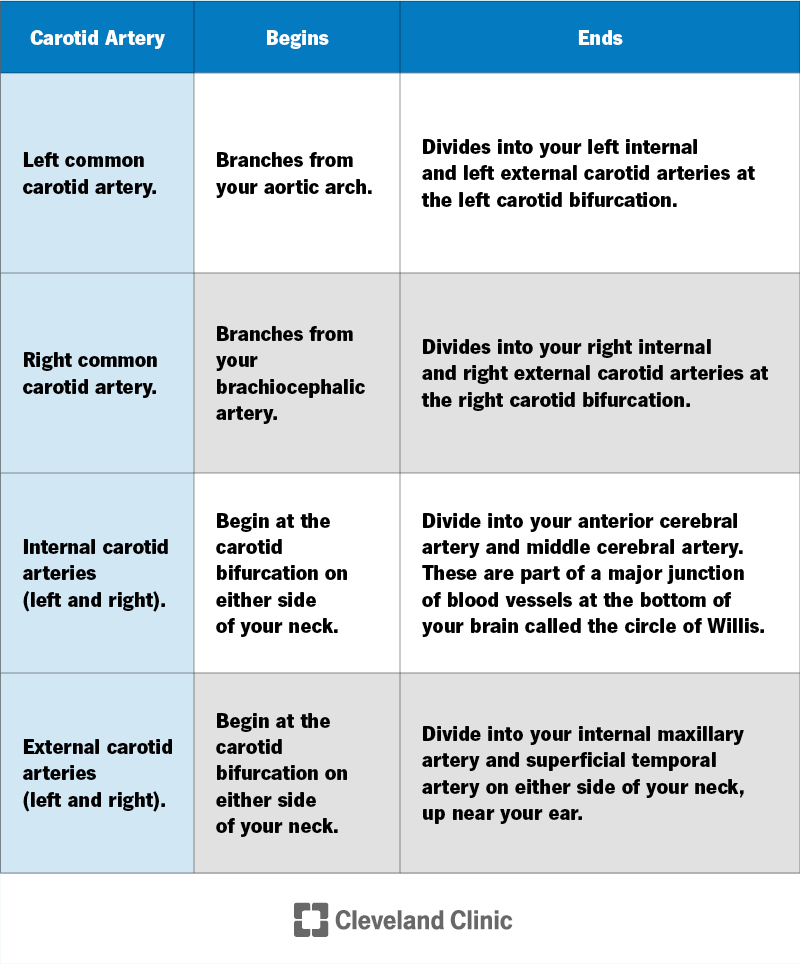Your carotid arteries supply blood and oxygen to your brain. Carotid artery disease is a common, serious condition affecting these arteries. It occurs when plaque builds up in your carotid arteries over time. This may limit or block blood flow to your brain, causing a stroke. Lifestyle changes and medications can lower your risk.
Advertisement
Cleveland Clinic is a non-profit academic medical center. Advertising on our site helps support our mission. We do not endorse non-Cleveland Clinic products or services. Policy

Your carotid arteries are blood vessels that supply blood to your brain, face and neck. You have two common carotid arteries, one on each side of your neck:
Advertisement
Cleveland Clinic is a non-profit academic medical center. Advertising on our site helps support our mission. We do not endorse non-Cleveland Clinic products or services. Policy
Your common carotid arteries travel from your upper chest to your skull. Along the way, each one divides (or “bifurcates”) into two branches:
Your internal and external carotid arteries give rise to many smaller artery branches that carry blood throughout your head and neck, nourishing your organs and tissues.
Your carotid arteries are an important part of your circulatory system. They send oxygen-rich blood to organs and tissues in your head and neck, including your brain.
Ideally, this is a smooth journey. But a blockage or blood clot in one of your carotid arteries can interfere with this process and cause serious complications.
Your carotid arteries are located primarily in your neck. They begin in your upper chest, just below your neck, and travel upward toward your skull. The chart below shows anatomical landmarks where each specific carotid artery begins and ends.

Your external carotid arteries begin at the carotid bifurcation on either side of your neck. Each external carotid artery travels upward along the side of your neck toward your ear. Near your ear, it divides into its two terminal branches: your maxillary artery and superficial temporal artery.
Advertisement
Your external carotid arteries each give rise to eight branches, which supply blood to many structures in your neck and face. These branches include your:
Your internal carotid arteries begin at the carotid bifurcation on either side of your neck. Each artery travels up through your neck until it reaches the base of your skull. Researchers call this part of the internal carotid artery the C1 or cervical segment. “Cervical” means something related to your neck.
Each internal carotid artery then goes through an opening in your skull known as the carotid canal. This is an anatomical landmark that divides the extracranial and intracranial parts of your artery. Extracranial means outside your skull, and intracranial means inside your skull. Once inside your skull, your internal carotid artery follows a twisting, winding path. Healthcare providers divide the intracranial part into six segments:
Some providers use other classification systems to describe these segments. For example, an older system divides your internal carotid artery into four parts:
Many people never need to know the names of these segments. But this information can be helpful if you have a condition like an aneurysm that affects your carotid arteries. Your healthcare provider may use these terms to describe the aneurysm’s location. An aneurysm is an abnormal dilation, or ballooning, of your blood vessel. It can form if the wall of the blood vessel is weakened by infection, damage or inflammation.
Your internal carotid arteries each give rise to several branches inside your skull. These arteries supply blood to your brain and eyes.
Branches of your internal carotid arteries include your:
Problems that can affect your carotid arteries include:
Advertisement
For most people, carotid artery conditions cause no symptoms until there’s a medical emergency like a TIA or stroke.
Call 911 or your local emergency number if you experience:
Depending on your symptoms, you may not be able to call for help. Educate your loved ones about these symptoms so they know when to seek help for you.
To check your carotid arteries, your provider may use a stethoscope to hear blood flow through your neck. They listen for a whooshing sound called a carotid bruit, which may indicate the presence of turbulent blood flow. Such blood flow can be a hint that there may be some plaque formation.
If you have a bruit, or your provider has other reasons to suspect problems, you may need imaging tests such as:
Medications and surgical procedures can treat narrowed or blocked carotid arteries. If you have a carotid artery blockage, your healthcare provider may recommend medications such as:
Advertisement
Procedures you may need include:
To keep your carotid arteries healthy, you may need to reduce your cholesterol levels. Your provider may prescribe medication to help.
You can also make lifestyle changes to support your blood vessels and heart, including:
You may want to ask your healthcare provider:
Advertisement
Your carotid arteries are a vital part of your circulatory system. They have the important job of sending oxygen-rich blood to your brain and other parts of your head and neck. If you have concerns about the health of your carotid arteries, talk to your healthcare provider. They can share information on lifestyle changes to help keep all of your blood vessels working at their best.
When your heart needs some help, the cardiology experts at Cleveland Clinic are here for you. We diagnose and treat the full spectrum of cardiovascular diseases.

Last reviewed on 10/11/2022.
Learn more about the Health Library and our editorial process.